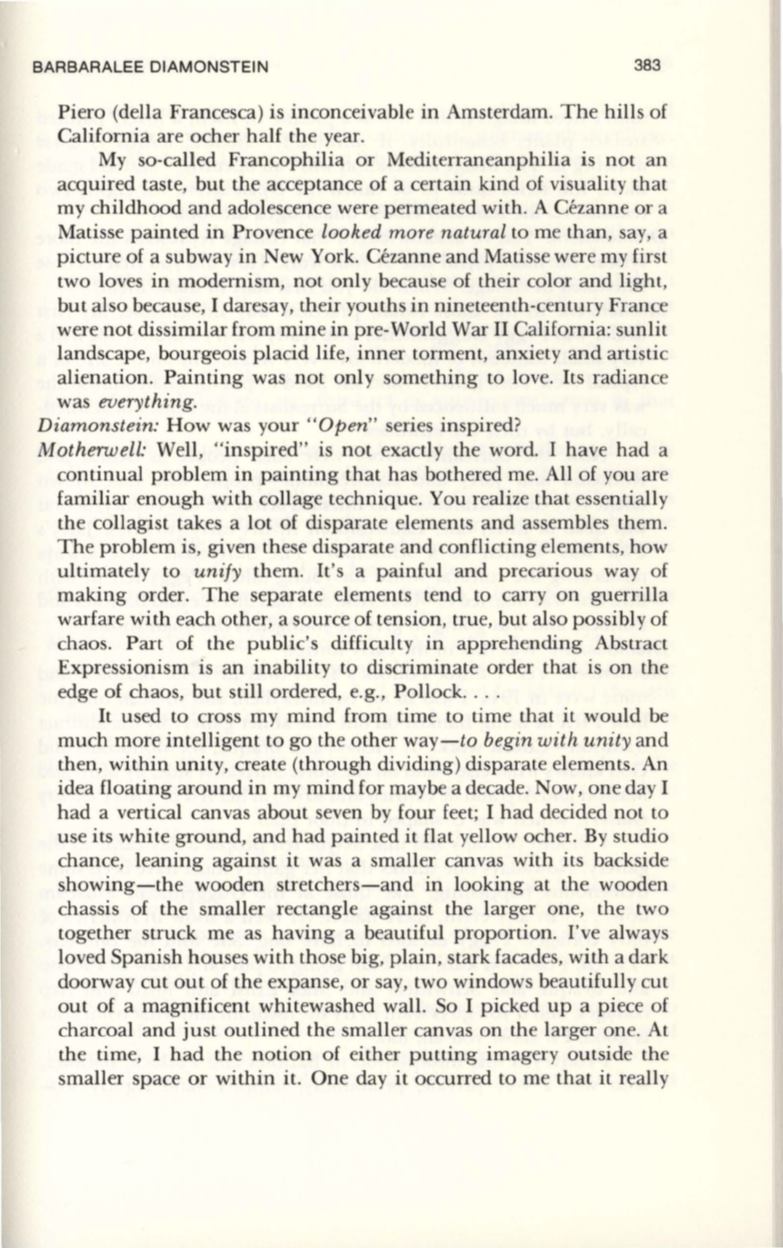
BARBARALEE DIAMONSTEIN
383
Piero (della Francesca) is inconceivable in Amsterdam. The hills of
California are ocher half the year.
My so-called Francophilia or Mediterraneanphilia is not an
acquired taste, but the acceptance of a certain kind of visuality that
my childhood and adolescence were permeated with. A Cezanne or a
Matisse painted in Provence
looked more natural
to me than, say, a
picture of a subway in New York. Cezanne and Matisse were my first
two loves in modernism, not only because of their color and light,
but also because, I daresay, their youths in nineteenth-century France
were not dissimilar from mine in pre-World War II California: sunlit
landscape, bourgeois placid life, inner torment, anxiety and artistic
alienation. Painting was not only something to love. Its radiance
was
everything.
Diamonstein:
How was your
" OPen"
series inspired?
Motherwell:
Well, "inspired" is not exactly the word. I have had a
continual problem in painting that has bothered me. All of you are
familiar enough with collage technique. You realize that essentially
the collagist takes a lot of disparate elements and assembles them.
The problem is, given these disparate and conflicting elements, how
ultimately to
unify
them. It's a painful and precarious way of
making order. The separate elements tend to carryon guerrilla
warfare with each other, a source of tension, true, but also possibly of
chaos. Part of the public's difficulty in apprehending Abstract
Expressionism is an inability to discriminate order that is on the
edge of chaos, but still ordered, e.g., Pollock.. . .
It used to cross my mind from time to time that it would be
much more intelligent to go the other
way-to begin with unity
and
then, within unity, create (through dividing) disparate elements. An
idea floating around in my mind for maybe a decade. Now, one day I
had a vertical canvas about seven by four feet; I had decided not to
use its white ground, and had painted it flat yellow ocher. By studio
chance, leaning against it was a smaller canvas with its backside
showing-the wooden stretchers-and in looking at the wooden
chassis of the smaller rectangle against the larger one, the two
together struck me as having a beautiful proportion. I've always
loved Spanish houses with those big, plain, stark facades, with a dark
doorway cut out of the expanse, or say, two windows beautifully cut
out of a magnificent whitewashed wall. So I picked up a piece of
charcoal and just outlined the smaller canvas on the larger one. At
the time, I had the notion of either putting imagery outside the
smaller space or within it. One day it occurred to me that it really


